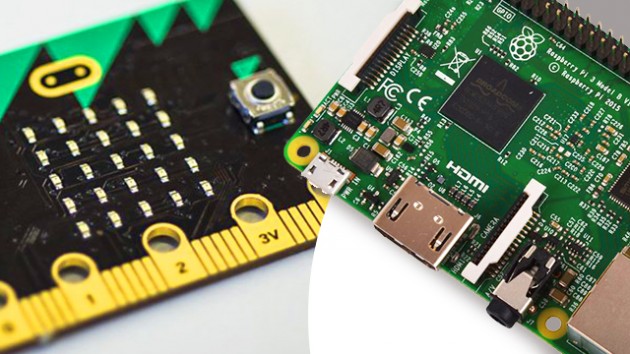While the BBC Micro Bit was expected to be unveiled in October 2015, months of setbacks prolonged the process. But now, these microcomputers are finally being delivered to one million UK children for free to help teach them the basics of computing. The project is inspired by the BBC Micro, which taught kids similar processes in the 1980s.

With the recent release of the BBC Micro Bit, you may wonder what exactly it does and how it stacks up to the current microcomputer legend, the Raspberry Pi 3. The Micro Bit is a simple, low-grade device aimed at basic, entry-level uses, but let’s take a look at the differences between these two microcomputers.
Design:
The BBC Micro Bit is intended as a gateway to the Raspberry Pi 3, which resembles a basic PC board with multiple recognizable connections. The Micro Bit is a 5 x 4cm circuit board with five basic input-output (I/O) rings for hooking up other devices or power. It has several functions attached directly, including 25 red LEDs that can be programmed to light up, as well as two programmable control buttons.
The Micro Bit operates at a more basic level than the Raspberry Pi 3, and is designed to interact with other devices rather than acting as a stand-alone system.
Power:
The Raspberry Pi 3 is equipped with a 1.2GHz 64-bit quad-core ARM Cortex-A53 CPU and Broadcom Videocore IV GPU with 1GB of RAM. The BBC Micro Bit boasts a 32-bit ARM Cortex M0 CPU with 16KB of RAM. The ARM processor that the Micro Bit runs on is the smallest available, and is designed to be extremely small, energy efficient, and easy to program. Its chip is significantly less powerful than the Raspberry Pi 3’s ARM Cortex-A53 CPU, which is the type you would find in an entry-level smartphone.
Connectivity:
Raspberry Pi 3: 4 x USB 2.0, 1 x HDMI, Ethernet, 3.5mm audio jack, 40 GPIO pins, Camera Interface, Display interface, MicroSD card slot, Wi-Fi, Bluetooth
BBC Micro Bit: 5 x I/O rings, Bluetooth Low Energy, Micro-USB controller, edge connector, compass, accelerometer
Despite being somewhat basic, the Raspberry Pi 3 has the recognizable connections of a modern computer. It has an HDMI slot, four 2.0 slots, an Ethernet port, a 3.5mm audio jack, Wi-Fi, and Bluetooth.
The Micro Bit has a core set of five I/O rings, which means you’ll need crocodile clips to physically hook it up to other devices like sensors or robots. It does feature Bluetooth, so you can connect it to phones and other devices wirelessly, and there’s an accelerometer and compass to use for directional applications or motion-based games.
One side of the Micro Bit is a standard edge connector, meaning it can physically be plugged into other devices such as the Raspberry Pi 3. If the Pi 3 is connected to the Micro Bit, then it will power it; otherwise, two AAA batteries will also get it going.
Software:
The Raspberry Pi 3 is a full processor-based device that runs on Linux and Windows 10, while the Micro Bit is an embedded software platform that does not run a full operating system. The Pi 3 also features a web-based user interface for editing in JavaScript, Python, C++, and Blocks.
The difference between the software shows how entry-level the Micro Bit truly is. It’s meant to teach children the building blocks of computing, while the Pi 3 has a more recognizable modern OS.
Price:
While the Raspberry Pi 3 is priced low at £30 ($42.63 U.S.), the BBC Micro Bit is free to year 7 students (ages 11-12). As most people aren’t year 7 students, the BBC has confirmed it will make the Micro Bit available for purchase, but it remains unclear when it will be available and at what price. However, we doubt it’s likely to exceed the price of the Raspberry Pi 3 since it’s much more basic.
Given the above comparisons, it’s clear what device is the winner. The Raspberry Pi 3 is a much more advanced and useful device. However, if your child is just beginning to learn to code, the BBC Micro Bit may be your best bet.
Via Trusted Reviews
Advertisement
Learn more about Electronic Products Magazine





